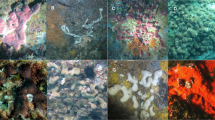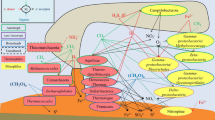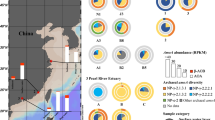Abstract
Stability of microbial communities can impact the ability of dispersed cells to colonize a new habitat. Saturated brines and their halophile communities are presumed to be steady state systems due to limited environmental perturbations. In this study, the bacteriorhodopsin-containing fraction of the haloarchaeal community from Eilat salt crystallizer ponds was sampled five times over 3 years. Analyses revealed the existence of a constant core as several OTUs were found repeatedly over the length of the study: OTUs comprising 52 % of the total cloned and sequenced PCR amplicons were found in every sample, and OTUs comprising 89 % of the total sequences were found in more than one, and often more than two samples. LIBSHUFF and UNIFRAC analyses showed statistical similarity between samples and Spearman’s coefficient denoted significant correlations between OTU pairs, indicating non-random patterns in abundance and co-occurrence of detected OTUs. Further, changes in the detected OTUs were statistically linked to deviations in salinity. We interpret these results as indicating the existence of an ever-present core bacteriorhodopsin-containing Eilat crystallizer community that fluctuates in population densities, which are controlled by salinity rather than the extinction of some OTUs and their replacement through immigration and colonization.



Similar content being viewed by others
References
Altschul SF, Gish W, Miller W, Myers EW, Lipman DJ (1990) Basic local alignment search tool. J Mol Biol 215:403–410. doi:10.1016/S0022-2836(05)80360-2
Anderson TW (1962) On the distribution of the two-sample Cramer-von Mises criterion. Ann Math Stat. doi:10.1214/aoms/1177704477
Antón J, Llobet-Brossa E, Rodríguez-Valera F, Amann R (1999) Fluorescence in situ hybridization analysis of the prokaryotic community inhabiting crystallizer ponds. Environ Microbiol 1:517–523
Bardgett RD, Lovell RD, Hobbs PJ, Jarvis SC (1999) Seasonal changes in soil microbial communities along a fertility gradient of temperate grasslands. Soil Biol Biochem 31:1021–1030. doi:10.1016/S0038-0717(99)00016-4
Benlloch S, Martínez-Murcia AJ, Rodríguez-Valera F (1995) Sequencing of bacterial and archaeal 16S rRNA genes directly amplified from a hypersaline environment. Syst Appl Microbiol 18:574–581. doi:10.1016/S0723-2020(11)80418-2
Benlloch S, Acinas SG, Antón J, López-López A, Luz SP, Rodríguez-Valera F (2001) Archaeal biodiversity in crystallizer ponds from a solar saltern: culture versus PCR. Microb Ecol 41:12–19. doi:10.1007/s002480000069
Benlloch S et al (2002) Prokaryotic genetic diversity throughout the salinity gradient of a coastal solar saltern. Environ Microbiol 4:349–360
Bidle K, Amadio W, Oliveira P, Paulish T, Hicks S, Earnest C (2005) Research article: a phylogenetic analysis of haloarchaea found in a solar saltern. BIOS 76:89–96. doi:10.1893/0005-3155(2005)076[0089:RAAPAO]2.0.CO;2
Boucher Y, Douady CJ, Sharma AK, Kamekura M, Doolittle WF (2004) Intragenomic heterogeneity and intergenomic recombination among haloarchaeal rRNA genes. J Bacteriol 186:3980–3990
Boujelben I et al (2012) Spatial and seasonal prokaryotic community dynamics in ponds of increasing salinity of Sfax solar saltern in Tunisia. A Van Leeuw J Microb. doi:10.1007/s10482-012-9701-7
Chao A (1984) Nonparametric estimation of the number of classes in a population. Scand J Statist 11:265–270
Chao A, Lee S-M (1992) Estimating the number of classes via sample coverage. J Am Stat Assoc 87:210–217
DeMaere MZ et al (2013) High level of intergenera gene exchange shapes the evolution of haloarchaea in an isolated Antarctic lake. Proc Natl Acad Sci USA 110:16939–16944. doi:10.1073/pnas.1307090110
Dickerson TL, Williams HN (2014) Functional diversity of bacterioplankton in three North Florida freshwater lakes over an annual cycle. Microb Ecol 67:34–44. doi:10.1007/s00248-013-0304-2
Dillon J, McMath L, Trout A (2009) Seasonal changes in bacterial diversity in the Salton Sea. Hydrobiologia 632:49–64. doi:10.1007/s10750-009-9827-4
Dillon JG, Carlin M, Gutierrez A, Nguyen V, McLain N (2013) Patterns of microbial diversity along a salinity gradient in the Guerrero Negro solar saltern, Baja CA Sur, Mexico. Front Microbiol 4:399. doi:10.3389/fmicb.2013.00399
Dyall-Smith M (ed) (2008) The halohandbook: protocols for haloarchaeal genetics, 7 edn. http://www.haloarchaea.com/resources/halohandbook/index.html
Edgar RC (2004) MUSCLE: multiple sequence alignment with high accuracy and high throughput. Nucleic Acids Res 32:1792–1797. doi:10.1093/nar/gkh340
Fernández AB, Vera-Gargallo B, Sanchez-Porro C, Ghai R, Papke RT, Rodríguez-Valera F, Ventosa A (2014) Comparison of prokaryotic community structure from Mediterranean and Atlantic saltern concentrator ponds by a metagenomic approach. Front Microbiol 5:196. doi:10.3389/fmicb.2014.00196
Ferris MJ, Ward DM (1997) Seasonal distributions of dominant 16S rRNA-defined populations in a hot spring microbial mat examined by denaturing gradient gel electrophoresis. Appl Environ Microbiol 63:1375–1381
Gasol J et al (2004) Control of heterotrophic prokaryotic abundance and growth rate in hypersaline planktonic environments. Aquat Microb Ecol 34:193–206
Ghai R et al (2011) New abundant microbial groups in aquatic hypersaline environments. Sci Rep 1:135. doi:10.1038/srep00135
Gomariz M, Martínez-García M, Santos F, Constantino M, Meseguer I, Antón J (2015a) Retinal-binding proteins mirror prokaryotic dynamics in multipond solar salterns. Environ Microbiol 17:514–526. doi:10.1111/1462-2920.12709
Gomariz M et al (2015b) From community approaches to single-cell genomics: the discovery of ubiquitous hyperhalophilic Bacteroidetes generalists. ISME J 9:16–31. doi:10.1038/ismej.2014.95
Grant S, Grant WD, Jones BE, Kato C, Li L (1999) Novel archaeal phylotypes from an East African alkaline saltern. Extremophiles Life Under Extreme Conditions 3:139–145
Guindon S, Dufayard JF, Lefort V, Anisimova M, Hordijk W, Gascuel O (2010) New algorithms and methods to estimate maximum-likelihood phylogenies: assessing the performance of PhyML 3.0. Syst Biol 59:307–321. doi:10.1093/sysbio/syq010
Hampel FR (1971) A general qualitative definition of robustness. Ann Math Stat 42:1887–1896
Javor BJ (1983) Planktonic standing crop and nutrients in a saltern ecosystem. Limnol Oceanogr 28:153–159. doi:10.4319/lo.1983.28.1.0153
Legault BA, López-López A, Alba-Casado JC, Doolittle WF, Bolhuis H, Rodríguez-Valera F, Papke RT (2006) Environmental genomics of “Haloquadratum walsbyi” in a saltern crystallizer indicates a large pool of accessory genes in an otherwise coherent species. BMC Genom 7:171. doi:10.1186/1471-2164-7-171
Litchfield CD (1998) Survival strategies for microorganisms in hypersaline environments and their relevance to life on early Mars. Meteorit Planet Sci 33:813–819
Litchfield CD, Gillevet PM (2002) Microbial diversity and complexity in hypersaline environments: a preliminary assessment. J Ind Microbiol Biotechnol 28:48–55. doi:10.1038/sj/jim/7000175
Litchfield CD, Irby A, Kis-Papo T, Oren A (2000) Comparisons of the polar lipid and pigment profiles of two solar salterns located in Newark, California, USA, and Eilat, Israel. Extremophiles Life Under Extreme Conditions 4:259–265
Litchfield CD, Oren A, Irby A, Sikaroodi M, Gillevet PM (2009) Temporal and salinity impacts on the microbial diversity at the Eilat, Israel solar salt plant. Global NEST J 11:86–90
Liu L, Yang J, Zhang Y (2011) Genetic diversity patterns of microbial communities in a subtropical riverine ecosystem (Jiulong River, southeast China). Hydrobiologia 678:113–125. doi:10.1007/s10750-011-0834-x
Liu L, Yang J, Yu X, Chen G, Yu Z (2013) Patterns in the composition of microbial communities from a subtropical river: effects of environmental, spatial and temporal factors. PLoS One 8:e81232. doi:10.1371/journal.pone.0081232
Lozupone C, Hamady M, Knight R (2006) UniFrac-an online tool for comparing microbial community diversity in a phylogenetic context. BMC Bioinform 7:371. doi:10.1186/1471-2105-7-371
Maddison D, Maddison W (2003) MacClade, 4.06 edn. Sinauer Associates, Sunderland
Martínez-Murcia AJ, Acinas SG, Rodríguez-Valera F (1995) Evaluation of prokaryotic diversity by restrictase digestion of 16S rDNA directly amplified from hypersaline environments. FEMS Microbiol Ecol 17:247–255. doi:10.1016/0168-6496(95)00029-A
Maturrano L, Santos F, Rosselló-Móra R, Antón J (2006) Microbial diversity in Maras salterns, a hypersaline environment in the Peruvian Andes. Appl Environ Microbiol 72:3887–3895. doi:10.1128/AEM.02214-05
Mutlu MB, Martínez-García M, Santos F, Peña A, Guven K, Antón J (2008) Prokaryotic diversity in Tuz Lake, a hypersaline environment in Inland Turkey. FEMS Microbiol Ecol 65:474–483. doi:10.1111/j.1574-6941.2008.00510.x
Mylvaganam S, Dennis PP (1992) Sequence heterogeneity between the two genes encoding 16S rRNA from the halophilic archaebacterium Haloarcula marismortui. Genetics 130:399–410
Narasingarao P et al (2012) De novo metagenomic assembly reveals abundant novel major lineage of Archaea in hypersaline microbial communities. ISME J 6:81–93. doi:10.1038/ismej.2011.78
Ochsenreiter T, Pfeifer F, Schleper C (2002) Diversity of archaea in hypersaline environments characterized by molecular-phylogenetic and cultivation studies. Extremophiles Life Under Extreme Conditions 6:267–274. doi:10.1007/s00792-001-0253-4
Oesterhelt D, Stoeckenius W (1973) Functions of a new photoreceptor membrane. Proc Natl Acad Sci USA 70:2853–2857
Oh D, Porter K, Russ B, Burns D, Dyall-Smith M (2010) Diversity of Haloquadratum and other haloarchaea in three, geographically distant, Australian saltern crystallizer ponds. Extremophiles Life Under Extreme Conditions 14:161–169. doi:10.1007/s00792-009-0295-6
Oren A (2002a) Diversity of halophilic microorganisms: environments, phylogeny, physiology, and applications. J Ind Microbiol Biotechnol 28:56–63. doi:10.1038/sj/jim/7000176
Oren A (2002b) Molecular ecology of extremely halophilic Archaea and Bacteria. FEMS Microbiol Ecol 39:1–7. doi:10.1111/j.1574-6941.2002.tb00900.x
Oren A (2006) Life at high salt concentrations. In: Dworkin M, Falkow S, Rosenberg E, Schleifer K-H, Stackebrandt E (eds) The prokaryotes. Springer, New York, pp 263–282. doi:10.1007/0-387-30742-7_9
Oren A, Shilo M (1981) Bacteriorhodopsin in a bloom of halobacteria in the Dead Sea. Arch Microbiol 130:185–187. doi:10.1007/BF00411075
Oren A, Duker S, Ritter S (1996) The polar lipid composition of Walsby’s square bacterium. FEMS Microbiol Lett 138:135–140. doi:10.1016/0378-1097(96)00085-7
Øvreås L, Daae FL, Torsvik V, Rodríguez-Valera F (2003) Characterization of microbial diversity in hypersaline environments by melting profiles and reassociation kinetics in combination with terminal restriction fragment length polymorphism (T-RFLP). Microb Ecol 46:291–301. doi:10.1007/s00248-003-3006-3
Papke RT, Douady CJ, Doolittle WF, Rodríguez-Valera F (2003) Diversity of bacteriorhodopsins in different hypersaline waters from a single Spanish saltern. Environ Microbiol 5:1039–1045
Papke RT, Zhaxybayeva O, Feil EJ, Sommerfeld K, Muise D, Doolittle WF (2007) Searching for species in haloarchaea. Proc Natl Acad Sci USA 104:14092–14097. doi:10.1073/pnas.0706358104
Pašic L, Bartual SG, Ulrih NP, Grabnar M, Velikonja BH (2005) Diversity of halophilic archaea in the crystallizers of an Adriatic solar saltern. FEMS Microbiol Ecol 54:491–498. doi:10.1016/j.femsec.2005.06.004
Pašic L, Ulrih NP, Crnigoj M, Grabnar M, Velikonja BH (2007) Haloarchaeal communities in the crystallizers of two adriatic solar salterns. Can J Microbiol 53:8–18
Podell S et al (2014) Seasonal fluctuations in ionic concentrations drive microbial succession in a hypersaline lake community. ISME J 8:979–990. doi:10.1038/ismej.2013.221
Rodriguez RL, Overholt WA, Hagan C, Huettel M, Kostka JE, Konstantinidis KT (2015) Microbial community successional patterns in beach sands impacted by the deepwater horizon oil spill. ISME J 9:1928–1940. doi:10.1038/ismej.2015.5
Rodriguez-Brito B et al (2010) Viral and microbial community dynamics in four aquatic environments. ISME J 4:739–751. doi:10.1038/ismej.2010.1
Rogers BF, Tate RL (2001) Temporal analysis of the soil microbial community along a toposequence in Pineland soils. Soil Biol Biochem 33:1389–1401. doi:10.1016/S0038-0717(01)00044-X
Rosner B (1983) Percentage points for a generalized ESD many-outlier procedure. Technometrics 25:165–172. doi:10.2307/1268549
Sabet S, Diallo L, Hays L, Jung W, Dillon JG (2009) Characterization of halophiles isolated from solar salterns in Baja California, Mexico. Extremophiles Life Under Extreme Conditions 13:643–656. doi:10.1007/s00792-009-0247-1
Schloss PD et al (2009) Introducing mothur: open-source, platform-independent, community-supported software for describing and comparing microbial communities. Appl Environ Microbiol 75:7537–7541. doi:10.1128/AEM.01541-09
Singleton DR, Furlong MA, Rathbun SL, Whitman WB (2001) Quantitative comparisons of 16S rRNA gene sequence libraries from environmental samples. Appl Environ Microbiol 67:4374–4376
Spearman C (1904) The proof and measurement of association between two things. Am J Psychol 15:72–101. doi:10.2307/1412159
Stoeckenius W, Bivin D, McGinnis K (1985) Photoactive pigments in halobacteria from the Gavish Sabkha. In: Friedman G, Krumbein W (eds) Hypersaline ecosystems, vol 53. Ecological studies. Springer, Berlin Heidelberg, pp 288–295. doi:10.1007/978-3-642-70290-7_16
Suzuki MT, Giovannoni SJ (1996) Bias caused by template annealing in the amplification of mixtures of 16S rRNA genes by PCR. Appl Environ Microbiol 62:625–630
Tavaré S (1986) Some probablilistic and statistical problems in the anlysis of DNA sequences. In: Miura RM (ed) Some mathematical questions in biology. American Mathematical Society, Providence
Tukey JW (1977) Exploratory data analysis. Addison-Wesley Publishing Company, Boston
Väätänen P (1980) Effects of environmental factors on microbial populations in brackish waters off the southern coast of Finland. Appl Environ Microbiol 40:48–54
Walsh DA, Papke RT, Doolittle WF (2005) Archaeal diversity along a soil salinity gradient prone to disturbance. Environ Microbiol 7:1655–1666. doi:10.1111/j.1462-2920.2005.00864.x
Winter C, Hein T, Kavka G, Mach RL, Farnleitner AH (2007) Longitudinal changes in the bacterial community composition of the Danube River: a whole-river approach. Appl Environ Microbiol 73:421–431. doi:10.1128/AEM.01849-06
Wright AD (2006) Phylogenetic relationships within the order Halobacteriales inferred from 16S rRNA gene sequences. Int J Syst Evol Microbiol 56:1223–1227. doi:10.1099/ijs.0.63776-0
Wu N, Schmalz B, Fohrer N (2011) Distribution of phytoplankton in a German lowland river in relation to environmental factors. J Plankton Res 33:807–820. doi:10.1093/plankt/fbq139
Zaccone R et al (2014) Seasonal dynamics of prokaryotic abundance and activities in relation to environmental parameters in a transitional aquatic ecosystem (Cape Peloro, Italy). Microb Ecol 67:45–56. doi:10.1007/s00248-013-0307-z
Zhaxybayeva O, Stepanauskas R, Ram-Mohan N, Papke RT (2013) Cell sorting analysis of geographically separated hypersaline environments. Extremophiles Life Under Extreme Conditions 17:265–275. doi:10.1007/s00792-013-0514-z
Acknowledgments
The authors thank Salt of the Earth Eilat Ltd. for allowing access to the Eilat salterns; the Interuniversity Institute for Marine Sciences of Eilat for logistic support; the UConn Bioinformatics Facility for providing computing resources; and the reviewers for their invaluable comments. This research was supported by the National Science Foundation (award numbers, DEB0919290 and DEB0830024), the US-Israel Binational Science Foundation (Grant Number 2013061) and NASA Astrobiology: Exobiology and Evolutionary Biology Program Element (Grant Numbers NNX12AD70G and NNX15AM09G).
Author information
Authors and Affiliations
Corresponding author
Additional information
Communicated by S. Albers.
Electronic supplementary material
Below is the link to the electronic supplementary material.
Rights and permissions
About this article
Cite this article
Ram-Mohan, N., Oren, A. & Papke, R.T. Analysis of the bacteriorhodopsin-producing haloarchaea reveals a core community that is stable over time in the salt crystallizers of Eilat, Israel. Extremophiles 20, 747–757 (2016). https://doi.org/10.1007/s00792-016-0864-4
Received:
Accepted:
Published:
Issue Date:
DOI: https://doi.org/10.1007/s00792-016-0864-4




